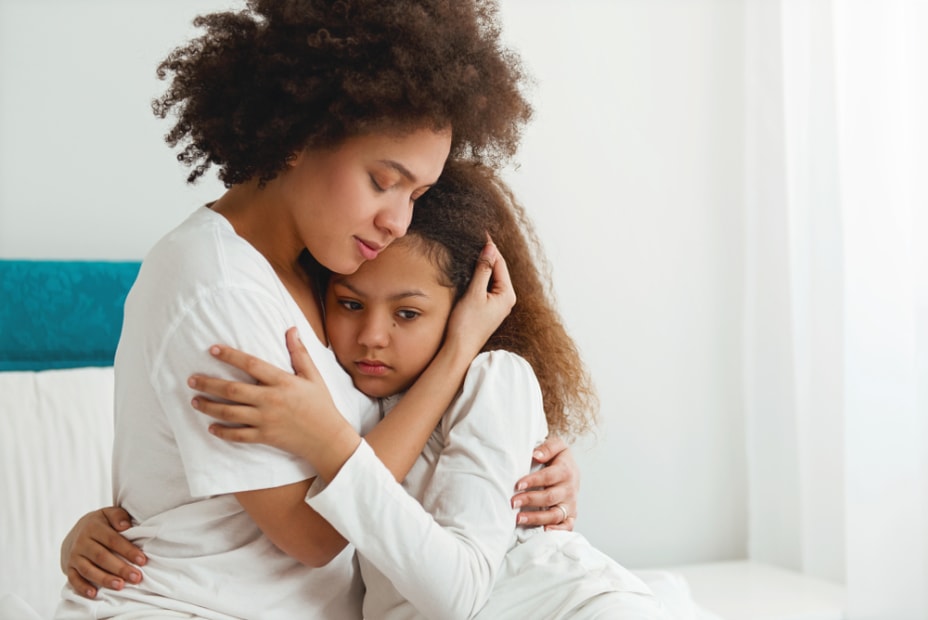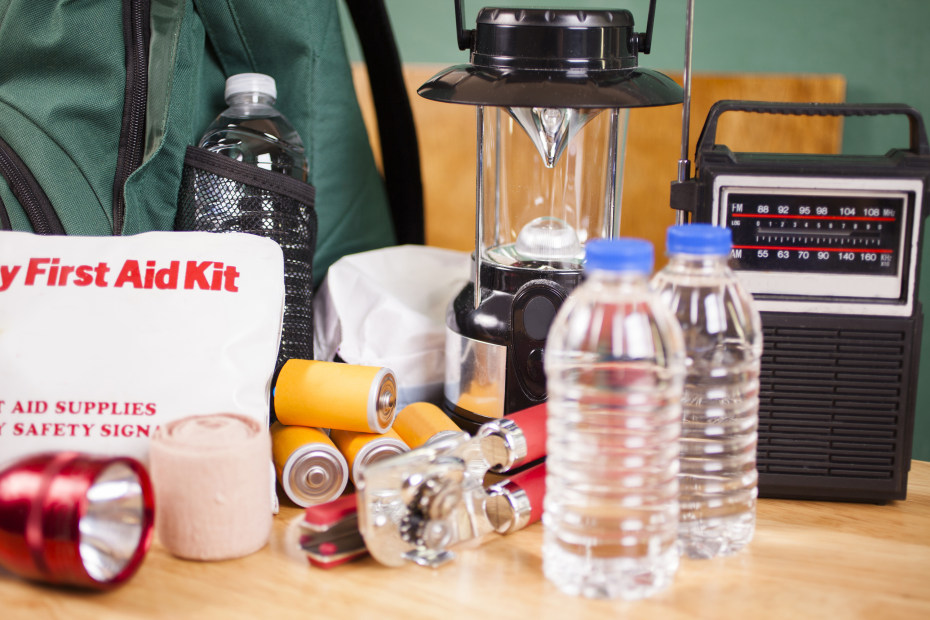As tremors across California remind us, it’s never too soon to prepare for an earthquake—especially if you live in the West. The simple steps you take now will help protect you and your household when the next round of shaking starts, and keep everyone safe in the event of aftershocks, an emergency, or a larger disaster.
1. Seek out a safe spot.
As part of your earthquake prep, examine each room of your home and figure out where to go when shaking starts. Contrary to popular belief, the safest place is not the nearest doorway, where you risk getting hit by a swinging door, breaking glass, or falling objects. It's better to move to an inside corner of the room, away from windows, light fixtures, shelves, and art or other hanging items that may shatter or fall. If possible, you want to take shelter under sturdy furniture, such as a solid wood or metal table, to protect yourself, according to Casey Brennan, senior director of social impact and advocacy at AAA Northern California, Nevada & Utah.
Do not move to another room or run outside: You’ll likely put yourself at greater risk. The area immediately next to any building is one of the most dangerous places to be because debris often falls off structures. Consider that some earthquakes are so powerful that you may not be able to walk or even crawl while it's happening. If you’re in bed, stay where you are, but roll over on your stomach and cover your head and neck with a pillow for protection.
Keep a bag secured to the underside of the bed containing hard-soled shoes, a flashlight with extra batteries, work gloves, and a whistle. (These utilitarian items may serve you well in other types of emergencies too.) If that sounds like overkill, consider that the most common injury resulting from the July 2019 Ridgecrest earthquake in Southern California was cut feet.
“The first thing to do after an earthquake is to put on shoes and clothes to be safe,” says Margaret Vinci, manager of earthquake programs at the Seismological Laboratory at the California Institute of Technology in Pasadena.
2. Practice “drop, cover, and hold on.”
This crucial safety precaution means exactly what it says: Drop to the ground on your hands and knees, wherever you are, and tuck your head in toward your legs. Cover your head and neck with one hand to help protect them from falling objects as you crawl to shelter, ideally under a sturdy piece of furniture. Hold on to the furniture with one hand while you cover your head and neck with the other.
The hazards aren’t over when the first wave of shaking stops. Aftershocks can come seconds, minutes, and days later. “Stay in your safe place until the shaking stops and you feel safe to move, but be aware of things that might fall after the shaking or with aftershocks,” Vinci says.
Practice the Drop, Cover, and Hold On drill with your family at least once a year. If you need a reminder, mark your calendar for the Great ShakeOut in October, when millions of people around the world participate in earthquake safety drills.
“The more you practice and know your safe places, the more your body will intuitively get you into the safe place before you even think about it,” Vinci says.

3. Involve everyone in your practice drills.
If you live with other people—kids, parents, friends, roommates—make sure they too are well-versed in earthquake safety. Explain why you’re going through the drill. Be factual without being alarmist: Earthquakes can be scary and dangerous, but drills are one of many ways we can protect ourselves.
During the Ridgecrest quake, adults were injured racing down hallways to get to their kids. “Talk to children old enough to understand to stay in bed until Mom and Dad come to get them after the shaking,” Vinci says.
Protect those who cannot move to safety themselves by keeping beds and cribs (with wheels locked) away from exterior walls and windows, as well as televisions, cabinets, and other objects that may fall. “Do not have anything above the bed or on the dressers that can fly across the room,” Vinci says. “All heavy objects should be down low.”
4. Establish a meeting place.
Because you may not be together when an earthquake hits, plan for where and when to gather after the shaking stops. For example, your home’s driveway could be your initial meeting space, as long as there are no immediate hazards nearby. As a general rule, open spaces away from power lines, tall trees, and brick structures are safest. Establish a timeline for when you’re all expected to gather. If the meeting time passes and you can’t locate or contact a member of your household, alert local authorities (see #5) and ask for their assistance.
Talk to your children about what to do if an earthquake strikes while they are at school and you are at work. “They should know that they will stay at school until Mom, Dad, or an assigned person can come and get them,” Vinci says. “But they should also know that it could be hours or longer if parents work far away.”
Parents with long commutes can ask friends or neighbors who are closer to school to pick up their kids in the event of an emergency; these details should be worked out in advance and included in your child’s file at school and your family’s communication plan at home.
5. Develop a communication plan.
Compile an emergency contact list—with numbers for local police, fire, and other emergency services—and keep it in your mobile phone and by your landline, if you have one. Also, create a family contact list and make sure everyone has access to it. The family list should include the number for an out-of-town or out-of-state friend or family member who may be in a better position to receive and relay messages.
In the aftermath of a quake, keep calls as brief as possible to avoid overburdening already busy cellular networks and draining your mobile phone’s battery. A text is often more efficient and more likely to get through to the person you’re trying to reach. If you have internet access, email and social media can also be effective ways to locate and/or communicate with family members.
Conserve the battery life on your mobile phone by dimming the screen’s brightness and turning on low power mode if available. As a backup, consider buying a satellite phone or messenger (a device that allows you to send text messages via satellite) and storing it somewhere accessible in case your cell service goes down.
All U.S. cities and counties have emergency and reverse-911 numbers that send automatic alerts to your mobile phone in the event of emergencies. You can sign up for these services through various apps and websites, including Smart911.com. Keep in mind, however, that cell phone service might be down in the wake of an earthquake, so having an alternate communication plan is important.

6. Put together earthquake preparedness kits.
Yes, kits—you should have more than one. Ideally, you’ll keep one at home, one by your desk at work, and one in the trunk of your car. (Some schools in earthquake-prone areas require students to store a kit in the classroom or store emergency supplies on site. If not, your child could keep a small bag in their desk or locker.)
Earthquake kits should include first-aid supplies such as antibiotic ointment, bandages, pain relievers, prescription medications and glasses, and splinting materials, as well as tools such as a flashlight, a battery-powered radio, and a whistle to signal for help. Kits should also be stocked with enough nonperishable food and water to last at least three days. The general rule is one gallon of water per person per day for drinking and sanitation.
Items should be stored in airtight containers and then placed in a larger container that’s easy to carry, such as a backpack. Update your earthquake kits at least once a year, replacing any expired items and making any modifications to suit your household’s shifting needs.
Smart Tip: Wondering what to put in your preparedness kits? Save time and hassle by ordering one with many of the essentials from Ready America. AAA Members get up to 30 percent off select Ready America products purchased online.
7. Remember to prep for your pet(s).
An emergency kit for your pet(s) should include food and water for at least five days, according to the Humane Society’s guidelines. Remember a leash, a harness, and a carrier for safe transport and to prevent escape, as well as a litter box and/or bags for collecting waste. Medications and medical supplies should be stored in a waterproof container.
It’s also wise to keep a pet first-aid kit that contains items such as gauze, a muzzle, a digital thermometer, and hydrogen peroxide. Keep photos of your pet(s) in your kit to help retrieve them if they’re lost and to verify ownership when you’re reunited.
Note that most emergency shelters do not allow pets. Ask a friend or a relative in advance if they would be willing to take your pet(s) in the wake of an emergency. Keep their contact information in your pet’s emergency kit.
8. Identify alternate shelter.
If your home is uninhabitable or unreachable after an earthquake, you’ll need somewhere else to sleep. You might turn to a friend, a family member, a neighbor, or a community-supported emergency shelter.
“It’s very important to have alliances,” says Gary Reid, a former insurance operations and specialty product manager for AAA. In addition to a family plan, you should have a neighborhood or community plan. To find out if one already exists in your area, call your local emergency management department. If not, you can start a neighborhood program through Map Your Neighborhood, a national organization that helps communities prepare for disasters.
9. Keep gas in the tank and cash on hand.
After a major earthquake, some standard services may be unavailable. Keeping your vehicle’s tank at least half-full at all times is a good idea; in addition to being prepared for an emergency, you'll never run out of gas. In terms of cash, estimate what you’d need to cover the bare necessities for a week, and stash that amount in small bills (ones, fives, and tens) in a safe, accessible place alongside your emergency kit.
10. Take a CPR class and other safety courses.
Your training could help save lives in the event of an emergency. The American Red Cross offers CPR and first-aid classes that take only a few hours to complete. Another valuable resource is the Community Emergency Response Team, a national program that educates volunteers in disaster preparedness, covering such topics as fire safety, light search and rescue, and disaster medical operations.
